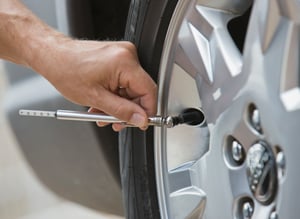 As colder temperatures settle in, you may notice a warning light on your car’s dashboard. While there are many warning lights to pay attention to, there’s one that tends to come on this time of year. The light I’m referring to is for your tire pressure monitoring system (TPMS). For every 10 degrees Fahrenheit, tire pressure can fluctuate from one to two pounds per square inch (PSI).
As colder temperatures settle in, you may notice a warning light on your car’s dashboard. While there are many warning lights to pay attention to, there’s one that tends to come on this time of year. The light I’m referring to is for your tire pressure monitoring system (TPMS). For every 10 degrees Fahrenheit, tire pressure can fluctuate from one to two pounds per square inch (PSI).
While my car’s tires are usually fine, it’s become a yearly tradition for the tires on our other vehicles to go below the recommended PSI when the temperatures drop. It happened to me again this year. I received a frantic text from my daughter asking what the light meant.
If not taken care of, low tire pressure can be dangerous. A lot rides on our tires. Not only the weight of the car but also our safety. Low tire pressure can cause the following problems:
- Reduced vehicle handling. Underinflated tires can cause poor cornering and braking along with diminished traction.
- Reduced gas mileage. Gas mileage tends to decrease during the winter months. Underinflated tires can cause increased drag which can lower gas mileage even further.
- Reduced tire life. Making unnecessary repairs isn’t fun. Low tire pressure can cause a blowout which can be frightening, especially if traveling at highway speeds. It also causes uneven wear, which will lead to early replacement.
- Reduced overall tire integrity. Driving with underinflated tires can make them more susceptible to punctures. If you live in a cold climate, you know potholes become a problem as winter progresses. Hitting a pothole can be startling if you don’t expect it. Blowing a tire as a result can be frustrating.
Here are some tips for preparing for and handling low tire pressure this winter:
1. If you’re driving, pull over.
If your light comes on while driving, pull over. This may indicate a more serious problem such as a punctured tire. When it’s safe, get out of your car and look. You’ll be able to tell if a tire is completely flat. If one is flat, call roadside assistance if you have it or a family member for help. Changing a flat tire on the side of a road can be difficult and dangerous.
2. Know the recommended tire pressure numbers for your vehicle.
More technologically advanced vehicles will display the tire pressure for each tire on a screen. This makes it easy to monitor them. If your vehicle doesn’t show you, it’s good to know where to find this information. The recommended cold tire pressures (PSI) are on a placard on the driver’s side doorjamb. Sometimes tire pressure requirements for front and rear tires differ, so read the entire card.
3. Keep a tire gauge in your car.
Pencil-like tire gauges are easy to use and affordable. It’s best to keep one in your vehicle no matter the time of the year.
4. Practice.
If you’ve never checked your tires before, practice obtaining a reading in the safety of your garage. Taking off the valve stem cap is simple. The slightly challenging part comes while attaching the gauge to the valve stem. If it’s not pushed on evenly, air will leak out of the valve stem reducing your tire pressure further. Practicing in a safe environment will help prevent this if it occurs away from your home.
Now’s the time to check your tires more regularly. If you rely on your mechanic to check your tire pressure only at oil changes or tire rotations, you could be putting yourself and your family at risk.
Do you have any suggestions or information you’d like to share? I’d love to hear from you. Please share them in the box below.





